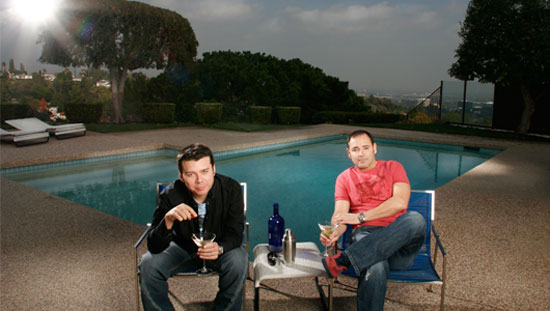With EDM having become a massive mainstream phenomenon, it’s imperative to remember the influence of that exhilarating first wave of trendsetters in the mid to late ’90s. The Chemical Brothers, The Prodigy, Basement Jaxx and the like wildly turned dance music on its head and veritably became the “rock” stars of the post-rave generation.
Las Vegas’ Crystal Method were one of America’s most dynamic representatives of that scene, their rousing 1997 breakbeat single “Busy Child” enjoying months of ubiquity. The duo of Scott Kirkland and Ken Jordan are returning now with their first new album in five years in January, and it features vocal collaborators such as LeAnn Rimes and The Voice’s Dia Frampton. But before 2013 is out they will also enjoy their inauguration as soundtrack composers, having been brought on to score J.J. Abrams’ highly anticipated new series Almost Human, which debuts Sunday, Nov. 17, on Fox.
Kirkland, who survived a harrowing brain operation earlier this year, was eager to elaborate in a chat with The Hollywood Reporter.
Much electronic music is about setting your mind in a mood, so it seems very well suited to soundtracking music and television.
Yeah, and growing up when I did … Star Wars was just so mind-boggling, every kid tried to go back and see it as many times as
possible in the theaters. I bought the score, and would just listen to it over and over again and imagine parts of the movie in my head. The imagination tries to create something bigger than just the song. It was the development of my understanding of music and pop culture.
And that played into the essence of rave?
Yes, that’s what the rave scene was: bigger than any one person, bigger than any one song … it was a spiritual thing. So this is the natural progression of our career.
How did you come to hook up with J.J. Abrams?
We got a phone call out of the blue about setting up a meeting. The producers wanted a gritty sound not typical of a TV score.
What intrigued you about the plot and premise of Almost Human?
Well, the storyline of being in the future, and this sort of broken cop and this synthetic robot coming together. There’s a little bit of Ken and me in those two. I was also a huge fan of Lost.
What were the challenges of creating music that wasn’t based on your own ideas?
We really just did what we wanted to do and fell back to the “guide” music every once in a while. But what was exciting for us was the dynamics. I was having a lot of fun playing around with the different time signatures, and not thinking about it being for the dance floor. So it’s actually less rigid. It’s opened up a whole new creative process for us.
The music on your new album is pretty hard-edged, but you have these much more, let’s say, graceful vocal collaborators, like Dia Frampton and LeAnn Rimes.
I didn’t watch The Voice, but I knew who Dia was. She is a really talented songwriter, and has an Edie Brickell quality; and there’s no drama working with her. We met LeAnn Rimes through the ReGeneration project. And even though she’s a country music star, when you strip down all the musicality around her voice, it’s just so soulful, and has a real beauty to it.
Are you okay with talking about your brain surgery?
It was a benign cyst that had probably been in my head since my early stages of development. If it had burst, it could have caused real damage. I had a really good doctor who was really calm; but then you have to sign these papers acknowledging you might wind up in a coma. It was only after I left the hospital that I got a full-blown infection, which was on the verge of meningitis — that was the really scary part.
In the ’90s Crystal Method was at the forefront of that first wave of dance culture. And now EDM has arrived at a very mainstream moment. How do you feel about what’s going on now?
When we released our first record, Vegas, in 1997, it was The Prodigy on the cover of Rolling Stone, and electronic music being the “next big thing.” And any time the media declares the next big thing, it’s going to be a complete disaster. But we never did anything just to be part of a scene — we never tried to do trance, to do jungle. We’re just a couple of guys who like big, distorted beats and synthesizers and guitar pedals. But we knew that the style and the energy would slowly and eventually permeate pop culture.


